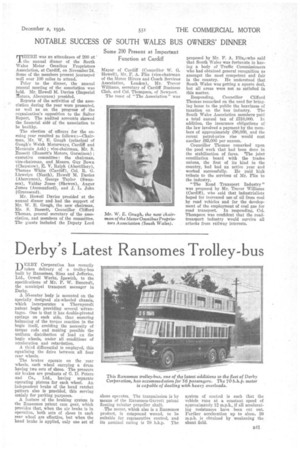Derby's Latest Ransomes Trolley-bus
Page 59

If you've noticed an error in this article please click here to report it so we can fix it.
TNERBY Corporation has recently taken delivery of a trolley-bus built by Ransomes, Sims and Jefferies, Ltd., Orwell Works, Ipswich, to the specifications of Mr. P. W. Bancroft, the municipal transport manager in Derby.
A 5(1-seater body is mounted on the specially designed six-wheeled chassis, which incorporates a Thornycroft patent bogie providing several advantages. One is that it has double-pivoted springs on each side, thus ensuring balancing of the torque reaction in the bogie itself, avoiding the necessity of torque rods and making possible the uniform distribution of load en the bogie wheels, under all conditions of acceleration and retardation.
A third differential is employed, this equalizing the drive between all four rear wheels, The brakes operate on the rear wheels, each wheel carrying a drum having two sets of shoes. The pressure air brakes are products of G. D. Peters and Co., Ltd., having separate operating pistons for each wheel. An independent brake of the hand ratchet pattern also is provided, this serving mainly for parking purposes.
A feature of the braking system is the Ransomes patent cam gear, which provides that, when the air brake is in operation, both sets of shoes in each rear wheel are effective, but when the hand brake is applied, only one set of shoes operates. The transmission is by means of the Ransomes-Gmett patent floating tubular propeller shaft.
, The motor, which also is a Ransomes product, is compound wound, to be suitable for regenerative control, and its nominal rating is 70 b.h.p. The system of control is such that the vehicle runs at a constant speed of approximately 12 m.p.h., if all accelerating resistances have been cut out. Further acceleration up to ahoy. 30 m.p.h. is obtained by weakening the shunt field.




































































































